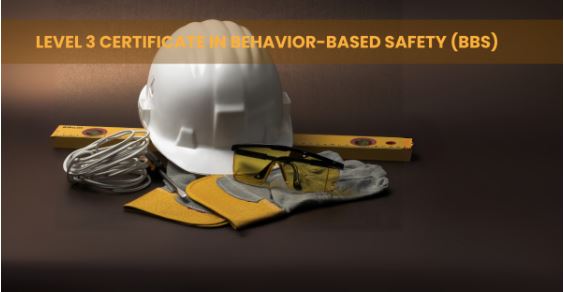
Level 3 Certificate in Behavior-Based Safety (BBS)
Course Overview
The Level 3 Certificate in Behavior-Based Safety (BBS) builds on foundational principles to equip professionals with advanced skills in identifying, analyzing, and mitigating unsafe workplace behaviors. This course emphasizes leadership, proactive engagement, and the application of strategic interventions to drive safety improvements. It is ideal for supervisors, managers, and safety professionals looking to create a culture of accountability and sustained behavioral change within their organizations.
Benefits
- Advanced Knowledge: Gain deeper insights into behavior analysis and its impact on workplace safety.
- Leadership Development: Strengthen leadership skills to guide and influence safety practices.
- Strategic Safety Management: Learn to design and implement comprehensive BBS programs.
- Career Growth: Enhance your credentials for mid- to senior-level safety roles.
Learning Outcomes
Upon completing this course, participants will:
- Master advanced techniques in behavioral observation and feedback.
- Analyze workplace safety trends and implement targeted solutions.
- Develop strategies to foster team accountability for safety.
- Implement and monitor BBS programs aligned with organizational goals.
- Measure the effectiveness of safety initiatives and make data-driven improvements.
Study Units
- Advanced Behavior Analysis.
- Understanding complex behavioral patterns and their root causes.
- Conducting comprehensive risk assessments based on observed behaviors.
- Behavioral Change Models.
- Applying psychological theories to drive sustained safety improvements.
- Encouraging voluntary compliance through positive reinforcement.
- Developing and Sustaining BBS Programs.
- Designing tailored behavior-based safety programs.
- Integrating BBS initiatives with existing safety protocols.
- Measuring and Enhancing Safety Performance
- Using metrics and KPIs to evaluate program success.
- Adapting strategies based on performance data and feedback.
- Leadership in Behavior-Based Safety
- Leading by example and fostering trust within teams.
- Motivating employees to prioritize safety behaviors.
Career Progression
This certification opens doors to advanced safety roles, such as:
- Behavior-Based Safety Manager: Design and oversee organization-wide BBS programs.
- Safety Consultant: Provide expert advice on behavior-based safety practices.
- HSE Supervisor: Lead teams in implementing and sustaining safety improvements.
- Safety Trainer: Educate teams on the principles and practices of BBS.
Our assessment process is designed to ensure every learner achieves the required level of knowledge, skills, and understanding outlined in each course unit.
Purpose of Assessment
Assessment helps measure how well a learner has met the learning outcomes. It ensures consistency, quality, and fairness across all learners.
What Learners Need to Do
Learners must provide clear evidence that shows they have met all the learning outcomes and assessment criteria for each unit. This evidence can take different forms depending on the course and type of learning.
Types of Acceptable Evidence
Assignments, reports, or projects
Worksheets or written tasks
Portfolios of practical work
Answers to oral or written questions
Test or exam papers
Understanding the Structure
Learning outcomes explain what learners should know, understand, or be able to do.
Assessment criteria set the standard learners must meet to achieve each learning outcome.
Assessment Guidelines
All assessment must be authentic, current, and relevant to the unit.
Evidence must match each assessment criterion clearly.
Plagiarism or copied work is not accepted.
All learners must complete assessments within the given timelines.
Where applicable, assessments may be reviewed or verified by internal or external quality assurers.
Full learning outcomes and assessment criteria for each qualification are available from page 8 of the course handbook.
Top Courses
No results found.
Related Courses
Let's Get in touch
Deleting Course Review
Course Access
This course is password protected. To access it please enter your password below:



